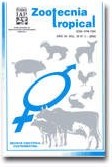
|
Zootecnia Tropical
Instituto Nacional de Investigaciones Agrícolas Venezuela
ISSN: 0798-7269
Vol. 27, No. 2, 2009, pp. 163-173
|
 Bioline Code: zt09019
Bioline Code: zt09019
Full paper language: Spanish
Document type: Research Article
Document available free of charge
|
|
|
Zootecnia Tropical, Vol. 27, No. 2, 2009, pp. 163-173
| en |
Non-genetic factors affecting birth weight in registered Brahman cattle
Rodríguez, Yhoangel; Martínez, Gonzalo G. & Galíndez, Rafael G.
Abstract
To determine the influence of some non-genetic factors on birth weight of Brahman registered cattle, 4078
observations were analyzed. All the animals were grazing and under sanitary management according to the
conditions of every herd. The statistical model included herd (H: 1 to 4), year of birth (AN: 1996 to 2005),
season of birth (EN: dry and rainy), age of mother at calving (EM: 3, …, 10 ó more years), and sex (S: males and
females) and the interactions H x AN, H x EN, H x S, AN x EN, and AN x EM. The average PN was 34.68 ± 0.29
kg. The PN was affected by all the environmental factors studied, except EN; however, some differences existed
between EN within H and AN due to the interactions H x EN and AN x EN. The effects S and H had the largest
effect on the variation of PN. The interactions with H indicate that the direction and magnitude of the effects are
not constant inside every herd. Important differences existed among herds, being 5.49 kg for the extreme ones.
The difference between the best years (2002 and 2005) and the worst year (1996) was 3.25 kg. Cows of 3, 4, and
10 ó more years gave birth smaller calves (in average 1.11 kg), than cows from 5 to 9 years. Male calves weighed
2.25 kg more than female.
Keywords
beef cattle, Brahman registered cattle, environmental factors, prenatal growth
|
| |
| es |
Factores no genéticos que afectan el peso al nacer en vacunos Brahman registrados
Rodríguez, Yhoangel; Martínez, Gonzalo G. & Galíndez, Rafael G.
Resumen
Para determinar la influencia de algunos factores no genéticos sobre el peso al nacer (PN) se analizaron 4.078
observaciones de becerros Brahman. Todos los animales se encontraban a pastoreo, bajo manejo sanitario
adecuado a las condiciones de cada hato. El modelo incluyó los efectos fijos hato (H: 1 a 4), año de nacimiento
(AN: 1996 a 2005), época de nacimiento (EN: seca y lluviosa), edad de la madre al parto (EM: 3,…,10 ó más
años) y sexo (S: macho y hembra) y las interacciones H x AN, H x EN, H x S, AN x EN y AN x EM. El promedio
ajustado para PN fue de 34,68 ± 0,29 kg. El PN fue afectado por todos los factores ambientales estudiados,
excepto EN, aunque sin embargo, si existió diferencias entre épocas dentro de H y AN. Los efectos S y H
fueron los que presentaron la mayor influencia sobre la variación de PN. Las interacciones con H indican que la
dirección y magnitud de los efectos no son constantes dentro de cada hato. Existieron diferencias de 5,49 kg entre
hatos extremos. La diferencia entre los mejores años (2002 y 2005) y el peor (1996) fue 3,25 kg. Vacas de 3, 4
y 10 ó más años parieron en promedio becerros menos pesados (1,11 kg) que las vacas de 5 a 9 años. Becerros
machos pesaron 2,25 kg más que las hembras.
Palabras-clave
ganado de carne, Brahman registrado, factores ambientales, crecimiento prenatal
|
| |
© Copyright 2009 - Zootecnia Tropical
Alternative site location: http://www.sian.inia.gob.ve/repositorio/revistas_ci/ZootecniaTropical/ztindice.htm
|
|
